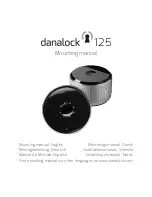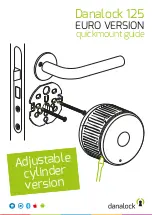
ODL User Guide v1.2
10 May 2020
sa-odl user guide v1.2.docx
SecureALL Corporation, Proprietary
Page: 3/5
3.
Caution & care
3.1.
The SA-ODL is very simple to install and uses the same hole drill-out as a standard Onity-CT30
lock.
3.2.
This device complies with part 15 of the FCC Rules. Operation is subject to the following two
conditions: (1) This device may not cause harmful interference, and (2) this device must accept
any interference received, including interference that may cause undesired operation.
3.3.
To reduce potential radio interference to other users, the antenna type and its gain should be so
chosen that the equivalent isotropically radiated power (E.I.R.P) is not more than that permitted
for successful communication.
3.4.
This device has been designed to operate with the antennas listed below, and having a maximum
gain of 4dBi. Antennas not included in this list or having a gain greater than 4 dB are strictly
prohibited for use with this device. The required antenna impedance is 50 ohms. Different
Antenna mounting plate may be used to position the antenna in desired proximity to the lock
cover (escutcheon).
a.
ODL Outside Antenna P/N: 810-000171
4.
Modes of operation
4.1.
Four operating modes are available to the SA-ODL upgraded lock:
4.1.1.
Standard Mode
– When the lock is in standard mode, a valid credential (card key) is
required to gain access to the lock.
4.1.2.
Office (Free) Mode
– The locks may be configured to allow Office (or Free) access. When
in this mode, no key is needed to gain access as the lock remains in the unlocked position.
The locks may be placed in and out of office mode in two ways:
a.
Present certain authorized cards twice
b.
Automatically as per programmed schedule
Note
: Only credential cards that are valid for the lock may be used to put the lock in and
out of office mode.
4.2.
Lockdown or Blocked Mode
– When a blocking card is presented to the lock, the Red LED will
start flashing and the lock will enter blocking mode. When a lock is blocked, no guest keys, and
only certain master users, will be allow access to the lock. To exit the blocking mode, present
the blocking card again to the lock. The Green LED will flash once to indicate that the blocking
has been removed.
4.3.
Privacy Mode
– When the privacy switch is engaged, typically when the deadbolt is engaged,
only valid keys with the privacy override will be able to access the room.
5.
SA-ODL Product Operation
5.1.
The SA-ODL can be configured (as desired) for either:
5.1.1.
Single-factor authentication (SFA): User may use either
5.1.1.1.
Present a credential card
5.1.1.2.
Press a secret PIN (personal identification number) code number on the Lock’s
keypad.
5.1.2.
Two-factor authentication (2FA): User shall first present a credential card followed by a
pressing a secret PIN code number on the lock’s keypad.
5.2.
Upon successful SFA or 2FA authentication























